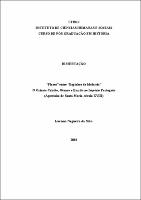Por favor, use este identificador para citar o enlazar este ítem:
https://rima.ufrrj.br/jspui/handle/20.500.14407/11461| Tipo do documento: | Dissertação |
| Título: | “Flores” entre “Espinhos de Idolatria” o oriente cristão, gênero e escrita no império português (Agostinho de Santa Maria, século XVIII) |
| Otros títulos: | "Flowers" among "Thorns of Idolatry" the Christian east, gender and writing in the portuguese empire (Agostinho de Santa Maria, eighteenth century) |
| Autor: | Silva, Luciana Nogueira da |
| Orientador(a): | Gonçalves, Margareth de Almeida |
| Primeiro membro da banca: | Faria, Patrícia Souza de |
| Segundo membro da banca: | Tavares, Célia Cristina da Silva |
| Palabras clave: | Agostinho de Santa Maria;Portugal;Oriente;Espiritualidade Feminina;Gênero;Agostinho de Santa Maria;Portugal;Orient;Female Spirituality;Gender |
| Área(s) do CNPq: | Ciências Humanas História |
| Idioma: | por |
| Fecha de publicación: | 20-abr-2018 |
| Editorial: | Universidade Federal Rural do Rio de Janeiro |
| Sigla da instituição: | UFRRJ |
| Departamento: | Instituto de Ciências Humanas e Sociais |
| Programa: | Programa de Pós-Graduação em História |
| Citación: | SILVA, Luciana Nogueira da. “Flores” entre “Espinhos de Idolatria” O Oriente Cristão, Gênero e Escrita no Império Português (Agostinho de Santa Maria, século XVIII). 2018. 143f. Dissertação (Mestrado em História, Relações de Poder, Linguagem e História Intelectual). Instituto de Ciências Humanas e Sociais. Departamento de História e Relações Internacionais. Universidade Federal Rural do Rio de Janeiro, Seropédica, RJ, 2018. |
| Resumen: | O objetivo desta dissertação é analisar a escrita religiosa de frei Agostinho de Santa Maria acerca de relatos de vidas de mulheres orientais (japonesas e cochinchinenses) convertidas ao cristianismo católico durante missionação ocorrida no Japão e na Cochinchina entre meados finais do século XVI e primeira metade do XVII. A divulgação dessas vidas foi feita por parte do autor com a publicação de duas obras laudatórias da espiritualidade feminina as quais deu o nome de Rosas do Japam e Rosas do Japam e da Cochinchina. Para o autor, a importância em “dar notícias” dessas vidas se justificava na missão de proporcionar aos “tíbios cristãos do reino” os exemplos das devotas cristãs orientais, que nascidas entre os espinhos da “cega gentilidade” e “abominável idolatria” deram testemunho de fortaleza diante de tribulações, perseguições e martírios sofridos durante a perseguição e banimento do Cristianismo ocorrida em seus respectivos “reinos”. É nosso intuito analisar a metodologia aplicada pelo autor na confecção de tais obras, assim como identificar quais eram, para Santa Maria, as condutas sociais e religiosas tidas pelo autor como ideais ao comportamento cristão. Soma-se a essa questão a constatação de que os livros de Agostinho de Santa Maria, não apenas evidenciam as sensibilidades religiosas reforçadas pela Igreja contrarreformista, como também divulgam um modelo de vida virtuosa para as mulheres em sociedades marcadamente misóginas e por isso buscamos também compreender os discursos religiosos de virtude e moral vigente no Setecentos português e veiculados pelo autor como garantidores de uma vida cristã perfeita. |
| Abstract: | The purpose of this research is to analyze the religious writings of Friar Agostinho de Santa Maria on the reports of the lives of Eastern (Japanese and Cochin) women converted to Catholic Christianity during a mission in Japan and Cochinchina between the middle of the 16th century and the first half of the XVII. The disclosure of these lives was made by the author with the publication of two laudatory works of feminine spirituality which gave the name of Roses of Japam and Roses of Japam and Cochinchina. For the author, the importance of "giving news" of these lives was justified by the mission of providing the "Christian trolls of the kingdom" with the examples of the Eastern Christian devotees who were born among the thorns of "blind gentility" and "abominable idolatry" of strength in the face of tribulations, persecutions and martyrdom suffered during the persecution and banishment of Christianity in their respective "kingdoms." It is our intention to analyze the methodology applied by the author in the making of such works, as well as to identify which were, for Santa Maria, the social and religious conduct considered by the author as ideals to Christian behavior. It adds to this question the fact that the books of Augustine de Santa Maria not only highlight the religious sensibilities reinforced by the counterreformist Church, but also reveal a model of virtuous life for women in societies markedly misogynist and therefore we also seek to understand the religious discourses of virtue and moral valid in the Portuguese Seventy and transmitted by the author as guarantors of a perfect Christian life. |
| URI: | https://rima.ufrrj.br/jspui/handle/20.500.14407/11461 |
| Aparece en las colecciones: | Mestrado em Ciências Sociais |
Se for cadastrado no RIMA, poderá receber informações por email.
Se ainda não tem uma conta, cadastre-se aqui!
Ficheros en este ítem:
| Fichero | Descripción | Tamaño | Formato | |
|---|---|---|---|---|
| 2018 - Luciana Nogueira da Silva.pdf | 2018 - Luciana Nogueira da Silva | 1.98 MB | Adobe PDF |  Visualizar/Abrir |
Los ítems de DSpace están protegidos por copyright, con todos los derechos reservados, a menos que se indique lo contrario.

